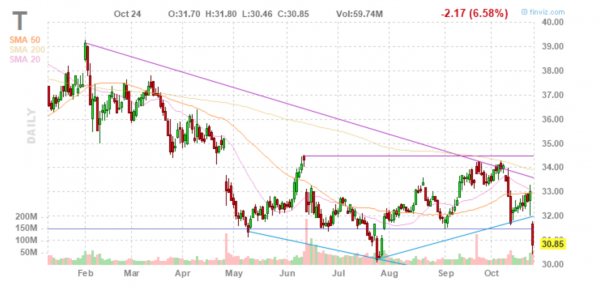AT&T's DirecTV Disaster Looms Large

Never been a fan of mega-conglomerates, bureaucracy, and bloated misguided M&A strategies. That pretty much sums up where AT&T may be headed, as its solid wireless profits were overshadowed by disastrous losses in its DirecTV subscribers, raising questions about its huge bets on content and DirecTV.
As I've pointed out repeatedly, AT&T is heading down a very risky path having adding $100 billion in debt over the past five years through the acquisitions of DirecTV ($67B) and then Time Warner ($80B). This in an industry that has never proven its skill in building diversified network-content conglomerates (does anybody remember Michael Armstrong?).
AT&T executives showed signs of whistling past the graveyard as their subscription satellite business is melting down. The DirecTV division lost 340,000 subscribers on the quarter, continuing a trend of losses. At the same time the over-the-top (OTT) content strategy slipped and shows signs of major confusion.
Executives didn't seem to notice.
“I’m pleased with the progress we made on a number of fronts in the third quarter,” said Randall Stephenson, AT&T chairman and CEO of AT&T, in a press release.
Stock Slammed 7%
Investors weren't pleased. The stock fell nearly 7%. In midday trading, AT&T shares traded hands at $30.88, down -2.14 (-6.48%).

Not all was lost. The company still makes money. The company reported adjusted third-quarter earnings of 90 cents per share on revenue of $45.7 billion, compared with 74 cents per share on revenue of $39.7 billion. It attributed five cents of profits to the gains from its $80 billion acquisition of Time Warner. Consensus estimates were for earnings of 75 cents per share on revenue of $45.6 billion.
The growth in revenue from the year-ago quarter, up 15.3%, was primarily due to the Time Warner acquisition. When adjusting for amortization, merger- and integration-related expenses and other items, operating income was $10.0 billion, or $9.4 billion on a comparative basis, versus $7.5 billion in the year-ago quarter, and operating income margin was 21.9%, or 20.3% on a comparative basis, versus 18.8% in the year-ago quarter.
The wireless divisions seems to be operating smoothly, with the core wireless unit gaining about 70,000 subscribers.
Yet, there's DirecTV. The glaring loss of 360,000 subscribers looms large. The company has been regularly reporting large subscriber losses. At the same time, the company reported only 49,000 new customers at DirecTV NOW, it's OTT content service. That's a huge drop from the 300,000+ DirectTV NOW subscribers the company gained in the second quarter.
On the conference call, AT&T executives attributed the OTT decline with a long-winded and confusing explanation around optimizing their promotional strategy in order to return to profitability. In other words, the customers it acquired with promotions in the past were not seen as profitable.
Looking at the quarter as a whole it seems like this: The massive $80 billion Time Warner acquisition added some profitability, to the tune of five cents per share. But we don't know how long that will last. The DirecTV unit continues to be a drag on the company, both financially and strategically.
Questions About Content Strategy?
In the end, it's going to lead to longer-term questions about AT&T's broad-based M&A strategy which I have noted has pushed the company to almost $200 billion in debt. It's not clear to me that AT&T management has the chops to integrate large content businesses into its business in a profitable way.
Contrast AT&T's quarter to Verizon's solid quarter, which was about wireless growth and profits. Verizon's share price was relatively stable.
Maybe its better that these larger wireless operators focus on one thing -- operating wireless and broadband networks - and not try to get to creative?
On a high note for technology suppliers, AT&T reaffirmed its net capital expenditures for the year in the $22 billion range. The company also confirmed 2018 guidance of adjusted EPS at the high end of $3.50 range, with free cash flow at the high end of the $21 billion range.
So, it's got time to work things out.












